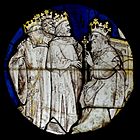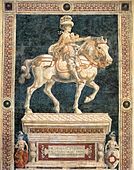Grisaille
This article needs additional citations for verification. (November 2021) |


Grisaille (/ɡrɪˈzaɪ/ or /ɡrɪˈzeɪl/; French: grisaille, lit. 'greyed' French pronunciation: [ɡʁizaj], from gris 'grey') means in general any European painting that is painted in grey. [1]
History
[edit]
Giotto used grisaille in the lower registers of his frescoes in the Scrovegni Chapel in Padua (c. 1304) and Robert Campin, Jan van Eyck and their successors painted grisaille figures on the outsides of the wings of triptychs, including the Ghent Altarpiece. Originally these were the sides on display for most of the time, as the doors were normally kept closed except on feast days or at the (paid) request of tourists. However, today these images are typically unseen in museums, the triptych displayed in its open state, flat against a wall. In these cases, imitation of sculpture was intended, as sculpture remained more expensive than a painting, even one by an acknowledged master.
Limners often produced illuminated manuscripts in pen and wash with a very limited colour range, and many artists such as Jean Pucelle (active c. 1320–1350) and Matthew Paris specialised in such work, which had been especially common in England since Anglo-Saxon times. Renaissance artists such as Mantegna and Polidoro da Caravaggio often used grisaille to imitate the effect of a classical sculptured relief or Roman painting.
In the Low Countries, a continuous tradition of grisaille painting can be traced from Early Netherlandish painting to Martin Heemskerck (1498–1574), Pieter Brueghel the Elder (Christ and the Woman Taken in Adultery, 1565) and Hendrik Goltzius, and through the copious output of Adriaen van de Venne, to the circle of Rembrandt and Jan van Goyen.
Portions of the ceiling frescoes of the Sistine Chapel are executed in grisaille, as is the lower section of the great staircase decoration by Antonio Verrio (c. 1636 – 1707) at Hampton Court.
Modern examples
[edit]Grisaille, while less widespread in the 20th century, persists as an artistic technique. Pablo Picasso's painting Guernica (1937) stands as a prominent example.
Contemporary American painter Hugo Bastidas has become known for black-and-white paintings that imitate the effect of grisaille and often resemble black-and-white photographs. His medium- and large-scale paintings feature contrasting zones of high and low detail.[2][3]
Enamel and stained glass
[edit]
The term is also applied to monochrome painting in other media such as those involving enamels, in which an effect similar to a relief in silver may be intended. Grisaille is also common in stained glass, as the need for sections in different colours is greatly reduced, such as York Minster's Five Sisters window. Portions of a window may be done in grisaille using, for example, silver stain or vitreous paint, while other sections are coloured glass.
Brunaille and verdaille
[edit]Monochrome work is sometimes executed in colours other than grey: a brunaille is a painting executed entirely or primarily in shades of brown, while a verdaille is the same for green. Such works are said to have been painted en brunaille or en verdaille, respectively.[4][5]
Brunaille and verdaille painting both have their roots in 12th century stained glass made for Cistercian monasteries, which prohibited the use of coloured art in 1134. The term "brunaille" was first used to refer to all-brown paintings in the 17th century.[5]
Gallery
[edit]-
Molded tile, mid-19th century Iran, Brooklyn Museum
-
Master of Frankfurt, Saint Odile and Saint Cecilia, ca. 1503–1506, oil on panel, Historical Museum, Frankfurt
-
Giotto, Scrovegni Chapel, Infidelity
-
Andrea del Castagno, monument to Niccolò da Tolentino
-
Triptych shutter outside panel by Hieronymus Bosch
-
2008 unveiling ceremony at The Kennedy Center of a Steinway Art Case piano painted in grisaille
-
Frans Francken II by Anthony van Dyck, one of a series of studies for portrait prints
-
Italian palace staircase, 18th century
-
Student copy in grisaille after Jacques-Louis David[6]
-
Painted Fire Screen by Jacques Vigoureux Duplessis, The Walters Art Museum. The pair of figures painted on the right side are in the grisaille style.[7]
-
Window of St. Peter: Stained glass (white glass, grisaille and silver sulfide) and lead, France, ca. 1500–1510
-
Odalisque in Grisaille, Jean Auguste Dominique Ingres and his workshop
See also
[edit]- Aizuri-e — ukiyo-e prints executed primarily or entirely in blue
- Monochrome painting — abstract art executed in a single color
- Pablo Picasso's Blue Period and Rose Period
- Sepia tone (photography)
- Zorn palette
- Valmer castle
References
[edit]- ^ Osborne, Harold, ed. (1970). The Oxford Companion to Art. Clarendon Press.
- ^ Dawson, Jessica. "Without Hue: A Rainbow of Grays". The Washington Post. Retrieved 16 February 2017.
- ^ Carvalho, Denise (April 2008). "Hugo Bastidas at Nohra Haime". Art in America: 169.
- ^ Christie’s, Sale 2437, Old Master Pictures, lot 51, Amsterdam, Christie’s, 8 November 1999
- ^ a b Christie’s, Sale 1380, Old Master Paintings, lot 49, New York, Christie’s, 17 June 2004
- ^ "Mims Studios School of Fine Art". Archived from the original on 5 August 2019. Retrieved 21 February 2009.
- ^ Old Masters Academy













![Student copy in grisaille after Jacques-Louis David[6]](http://upload.wikimedia.org/wikipedia/commons/thumb/6/68/David_patroclus_mimsstudios_grisaille.jpg/170px-David_patroclus_mimsstudios_grisaille.jpg)
![Painted Fire Screen by Jacques Vigoureux Duplessis, The Walters Art Museum. The pair of figures painted on the right side are in the grisaille style.[7]](http://upload.wikimedia.org/wikipedia/commons/thumb/4/48/Jacques_Vigoureux_Duplessis_-_Painted_Fire_Screen_-_Walters_372479.jpg/170px-Jacques_Vigoureux_Duplessis_-_Painted_Fire_Screen_-_Walters_372479.jpg)

